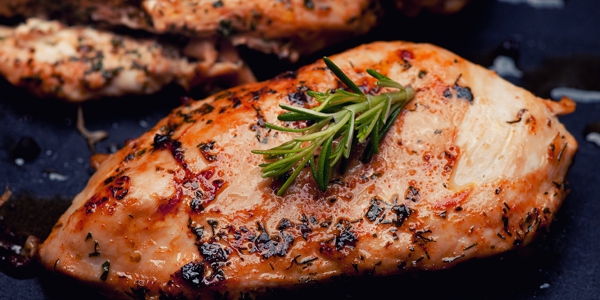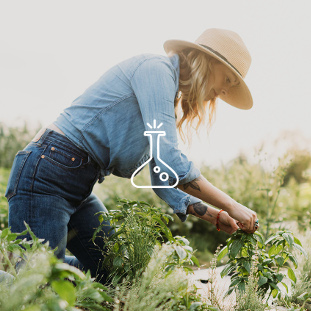‘The weekly shop’ has been forming a ritual for people all over the world for quite some time. This regular activity is often overlooked and plays at the same time a major role in the way we live. This habit has been changing, and continues to change, over time. William remembers, “When I look back, to when I first moved out of my parents’ home and started buying groceries for myself – my approach was so different! I would try to get the supermarket visit out of the way as quickly as possible: rushing around, grabbing whatever items were on special offer, or looked the tastiest, or easiest to cook.” As William pauses to studiously compare the labels on two different pots of chilled chicken soup, it becomes clear that things have changed somewhat ...
“I think that great taste continues to be the most important thing that I look for,” says William. “And in recent years, I’ve definitely started taking more interest in ‘natural’ and “close by grown” ingredients. I want to know where the ingredients come from. Are they being prepared in a way that retains their natural qualities? How many admixtures do they contain? I guess I’m just generally more conscious about the products I consume, especially when it comes to food and beverages.” William looks down again at the two pots in his hands. He returns one to the refrigerated shelf and places the other, which proudly declares ‘Always Natural’ on the label, into his shopping kart.

When I look back, to when I first moved out of my parents’ home and started buying groceries for myself – my approach was so different!William, The content strategist
A true global movement

William knows many fellows in his heightened interest in ‘naturalness’. The very next day in the company kitchen, he heats up his chilled chicken soup. Soon, his international colleagues gather around him to find out where this delicious smell comes from. “Hmm, this reminds me of home. Fresh and spicy chipotle chilies add a tasty twist to every chicken soup, as my grandma used to say. I still remember that tickling on my tongue from her favorite dish!” exclaims Pablo the graphic designer from Mexico City. “Does it have real chipotles in it?” William looks at the label of the pot and nods affirmative. “And they do have African, Indian, Thai, Chinese, and European varieties as well – all with real natural and understandable ingredients. I can bring them for you to taste the next time I go to my supermarket” The crowd cheers with joy and anticipation. At this moment Gaelle Dami enters the room just overhearing the last sentences of William’s. The Swiss lady works for Symrise as global marketing communication specialist. With William’s team, she is working on a global naturalness campaign. She asks: the small kitchen gathering: “What do you expect from a food or beverage so that you recognize it as natural?”

“I want to understand the words on the ingredient list, which makes the food credible to me. It inspires confidence in me. I can understand everything with my amount of knowledge”, says William spontaneously. Amy, the social media specialist, from the US adds: “I want real food declared as food and natural flavors on the labels. I accept a product if it uses generic terms.” “Exactly!”, agrees Chen, market researcher from Singapore. “Kitchen-like ingredients instead of scientific expressions make me feel good about the food. Pablo smiles and says: “It gives me a feeling of home if I see familiar methods linked to kitchen processes, like my grandmas cooking instead of industrial manufacturing processes.” And Rashid with his Indian-Moroccan background finds: “Above all, I want to see that key ingredients are from real sources from real fairly-treated farmers. I am explicitly looking for words such as ‘natural’ and ‘organic’ and ‘sustainable’.”
On a global level consumers are attracted by the explicit use of words like “natural”, “organic” or “fresh”. These words have a great influence on the perception and acceptance of a product or its ingredients. In addition, consumers around the world reject ingredients with scientific-sounding names because they do not perceive them as natural. In order to understand and trust the content of the label, consumers looking for concrete and transparent information and prefer familiar methods of food preparation.

“This has definitely gone beyond a niche ‘trend’ – we now describe it more as a movement,” says Gaelle, who is also the global lead for code of nature™, the strategic naturalness platform of Symrise. “This development is inspired by the craft trend having swapped over from the US. Finely crafted foods and beverages come from manufacturers that produce specially developed products in generally small quantities. Consumers agree that quality, the attention to detail, and the variety make a good craft product. This shows people want to trust the food and beverages they consume, and their producers need to be able to deliver that credibly. Transparent, honest products are only possible if ingredients fulfill the desired criteria in the first place. And delivering true natural products is a complex task. As versatile as your crowd’s chicken soup preferences are the global concepts of naturalness. This depends on many things, such as region, legal status and product categories.”
What do consumers want?
William and his team seem to be curious to learn more about global taste and naturalness preferences. “Give us some numbers and figures, some researched background”, William demands. “Ok. Come on let’s have a joint look on one of our research results”, Gaelle continues: With our knowledge about the versatile consumer preferences in mind, we carried out intensive research on a global level. We want to make sure that the natural taste we develop can help food and beverage producers to meet market demands.
We want to make sure that the natural taste we develop can help food and beverage producers to meet market demands.Gaelle Dami, Marketing Communication Director code of nature™ Symrise
For example, in March 2017, we carried out a study in the US. We found that naturalness was most sought-after in the yoghurt category by 68 % of consumers. We had the lowest figures in the ready-to-eat (RTE) meals category. Still, almost 47 %, i. e. half of the consumers surveyed said that naturalness was a quality they looked for.

We found it also interesting to compare yoghurts and RTE meals, because they highlight what we’ve discussed earlier. Naturalness contains various meanings. For instance, consumers in the US expect subtle differences from their brands in terms of most impactful ‘clean labelling’. People are looking for organic ingredients and freshness claims on yoghurt packaging. In RTE meals, they are more interested in respectful breeding of animals.”
Discovering real chicken or what is ‘clean labelling’?
“Speaking of clean labelling”, remarks Amy from the US. “Can you tell us more about this somehow very vague term?” “Yes!” says Gaelle. “Actually, we have looked thoroughly into what makes a chicken dish a real authentic, trustworthy and also great-tasting product for consumers.

For us as well as for food and beverage producers, it is crucial to make our labels clean, i. e. with as little and as natural ingredients as possible and free from things consumers perceive as alien to them. They want kitchen-like ingredients, in particular if we are speaking about culinary applications, such as chicken soup.
We also recognized that ‘trustworthy’ means different things in different countries – the culinary backgrounds of different cultures results in specific nuances between appealing and less-appealing word choices. For example, ‘natural chicken flavorings’ is more enticing to consumers in the UK and France than in Germany. In Germany, consumers respond very positively to ‘boiled chicken preparation’ – a term that resonates little with their counterparts in the UK and France.
Based on this knowledge, we have developed a chicken taste that delivers a high-intensity, authentic chicken taste from real chickens. Our goal was creating solutions that use the most delicious white, dark and roasted meat in a way that consumers can both, enjoy and trust. Rather than resulting in confusing or vague ingredients lists with lots of additives, our chicken range enables relatable, simple and enticing terms.”



Our goal was creating solutions that use the most delicious white, dark and roasted meat in a way that consumers can both, enjoy and trust.Gaelle Dami, Marketing Communication Director Flavor Symrise for code of nature™
Transforming insights into the best possible code of nature


“Ah, that is interesting”, Sergej says. “So, you understand the varying concepts of naturalness. How do you ensure to deliver most impactful and appealing taste? Let me put it like this: The taste of organically grown oranges is naturally more susceptible to the whims of nature. How do you ensure that our orange juice comes with the same great taste that we, the consumers, love that much?”
Gaelle smiles softly: “We give the answer with our code of nature™. It works as follows: First, we used our research from all over the world. Our flavor teams distilled the demands for ‘naturalness’ from our insights into a set of four overarching pillars for developing taste solutions. While the importance and specific meanings of these factors can change by region and product category, the principle remains the same. By combining our four pillars for each and every customer, we make sure that their products meet the naturalness criteria in the most suitable and individually-tailored ways and also ensure great taste.

Consumer driven
Creating natural taste experiences based on consumer insights and in house sensory research.

Best naturals
Respectfully sourcing from people & places we know and trust.

Applied science
Proprietary technologies and gentle preparation methods for natural taste.

Regulatory guidance
Regulatory guidance to navigate the complex and changing regulatory landscape and create labels consumer understand and trust.

Natural X Flavoring Collection
Sourcing, refining and creating your natural taste solutions. Create signature tastes for your products. We are supplying you with the best from the named sources – from 95/5 Flavorings up to 100% from the named source.
Discover our collections for sweet, dairy, culinary food and beverages.
The future of naturalness

William and his team are excited about code of nature™. And naturally, they want to know what comes next and how Symrise inspires the consumer of tomorrow. “While naturalness is certainly here to stay, we are ever-mindful of the different directions that this can head in. For example, while clean labelling is currently the priority for most food and beverage producers as well as consumers, it could be that in five years the focus shifts to another area,” says Gaelle. “Remember, nature itself is always changing! With code of nature™, we are well-equipped to anticipate and deliver against any such changes.”

The natural chicken soup has convinced the group. The Italian Maria has one last question: “How do you make sure that you can draw on the best natural ingredients in the future as well?” Gaelle can give a good answer to this question too: “We are well aware of the importance to reliably source sustainable and natural raw materials. We are supporting our ever-evolving commitment to naturalness by our 2014 acquisition of the French Diana Group. They are global leaders in many nature-derived, high-quality solutions for the food, pet food and aquaculture industries. Diana enables us to achieve more backward integration across a number of our most important categories – particularly for our culinary ingredients. This enables us to increase our impact on our supply chains all over the world. They are crucial to our business, because they ensure we can sustainably source, high-quality ingredients for high quality taste solutions.”

The lunch break and the chicken soup tasting in the small canteen of William’s company is over and all agree on one fact. It takes both: Providing natural solutions specifically tailored to the growing demands of today and ensuring that the most pioneering processes are in place for the next generation of consumers in developed and emerging markets. Cracking the code of nature and then building up a unique code for the needs of the many food and beverage providers will lead to great taste that consumers around the world cherish and love.


